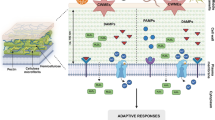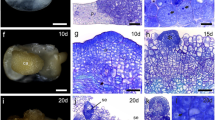Abstract
Ethylene induced an endochitinase in primary leaves of Phaseolus vulgaris L. The enzyme formed chitobiose and higher chitin oligosaccharides from insoluble, colloidal or regenerated chitin. Less than 5% of the total chitinolytic activity was detected in an exochitinase assay proposed by Abeles et al. (1970, Plant Physiol. 47, 129–134) for ethylene-induced chitinase. In ethylene-treated plants, chitinase activity started to increase after a lag of 6 h and was induced 30 fold within 24 h. Exogenously supplied ethylene at 1 nl ml−1 was sufficient for half-maximal induction, and enhancement of the endogenous ethylene formation also enhanced chitinase activity. Cycloheximide prevented the induction. Among various hydrolases tested, only chitinase and, to a lesser extent, β-1,3-glucanase were induced by ethylene. Induction of chitinase by ethylene occurred in many different plant species. Ethylene-induced chitinase was purified by affinity chromatography on a column of regenerated chitin. Its apparent molecular weight obtained by sodium dodecyl sulfate-gel electrophoresis was 30,000; the molecular weight determined from filtration through Sephadex G-75 was 22,000. The purified enzyme attacked chitin in isolated cell walls of Fusarium solani. It also acted as a lysozyme when incubated with Micrococcus lysodeikticus. It is concluded that ethylene-induced chitinase functions as a defense enzyme against fungal and bacterial invaders.
Similar content being viewed by others
Abbreviations
- ACC:
-
1-aminocyclopropane-1-carboxylic acid
- AVG:
-
aminoethoxyvinylglycine
- GlcNAc:
-
N-acetylglucos-amine
References
Abeles, F.B. (1973) Ethylene in plant biology. Academic Press, New York London
Abeles, F.B., Bosshart, R.P., Forrence, L.E., Habig, W.H. (1970) Preparation and purification of glucanase and chitinase from bean leaves. Plant Physiol. 47, 129–134
Altmann, A., Kaur-Sawhney, R., Galston, A.W. (1977) Stabilization of oat leaf protoplasts through polyamine-mediated inhibition of senescence. Plant Physiol. 60, 570–574
Araki, Y., Ito, E. (1975) A pathway for chitosan formation in Mucor rouxii. Enzymatic deacetylation of chitin. Eur. J. Biochem. 55, 71–78
Berger, L.R., Reynolds, D.M. (1958) The chitinase system of a strain of Streptomyces griseus. Biochim. Biophys. Acta 29, 522–534
Boller, T., Kende, H. (1979) Hydrolytic enzymes in the central vacuole of plant cells. Plant Physiol. 63, 1123–1132
Bradford, M.M. (1976) A rapid and sensitive method for the quantitation of microgram quantities of protein utilizing the principle of protein-dye binding. Anal. Biochem. 72, 248–254
Cabib, E., Bowers, B. (1971) Chitin and yeast budding. J. Biol. Chem. 246, 152–159
Eastwell, K.C., Bassi, P.K., Spencer, M.E. (1978) Comparison and evaluation of methods for the removal of ethylene and other hydrocarbons from air for biological studies. Plant Physiol. 62, 723–726
Glazer, A.N., Barel, A.O., Howard, J.B., Brown, D.M. (1969) Isolation and characterization of fig lysozyme. J. Biol. Chem. 244, 3583–3589
Hadwiger, L.A., Beckman, J.M. (1980) Chitosan as a component of pea-Fusarium solani interactions. Plant Physiol. 66, 205–211
Hestrin, H., Feingold, E.S., Schramm, M. (1955) Hexoside hydrolases. Methods Enzymol. 1, 231–257
Howard, J.B., Glazer, A.N. (1967) Studies of the physicochemical and enzymatic properties of papaya lysozyme. J. Biol. Chem. 242, 5715–5723
Konze, J.R., Kwiatowski, M.K. (1981) Rapidly induced ethylene formation after wounding is controlled by the regulation of ACC synthesis. Planta 151, 327–330
Laemmli, U.K. (1970) Cleavage of structural proteins during the assembly of the head of bacteriophage T4. Nature (London) 227, 680–685
Lieberman, M. (1979) Biosynthesis and action of ethylene. Annu. Rev. Plant Physiol. 30, 533–591
Molano, J., Duran, A., Cabib, E. (1977) A rapid and sensitive assay for chitinase using tritiated chitin. Anal. Biochem. 83, 648–656
Molano, J., Polacheck, I., Duran, A., Cabib, E. (1979) An endochitinase from wheat germ. J. Biol. Chem. 254, 4901–4907
Montalbini, P., Elstner, E.F. (1977) Ethylene evolution by rustinfected, detached bean (Phaseolus vulgaris L.) leaves susceptible and hypersensitive to Uromyces phaseoli (Pers.) Wint. Planta 135, 301–306
Nichols, J.E., Beckman, J.M., Hadwiger, L.A. (1980) Glycosidic enzyme activity in pea tissue and pea-Fusarium solani interactions. Plant Physiol. 66, 199–204
Otakara, A. (1961) Studies on the chitinolytic enzymes in blackkoji mold. II. Purification of chitinase. Agr. Biol. Chem. 25, 54–60
Pegg, G.F. (1976) The involvement of ethylene in plant pathogenesis. In: Encyclopedia of plant physiology, N. S., vol. 4, pp. 582–591, Heitefuss, R., Williams, P.H., eds. Springer, Berlin Heidelberg New York
Pegg, G.F. (1977) Glucanohydrolases of higher plants: a possible defense mechanism against parasitic fungi. In: Cell wall biochemistry related to specificity in host-plant pathogen interactions, pp. 305–345, Solheim, B., Raa, J., eds. Universitetsforlaget, Tromsø Oslo Bergen
Pegg, G.F., Vessey, J.C. (1973) Chitinase activity in Lycopersicon esculentum and its relationship to the in vivo lysis of Verticillium albo-atrum mycelium. Physiol. Plant Pathol. 3, 371–382
Pegg, G.F., Young, D.H. (1981) Changes in glycosidase activity and their relationship to fungal colonisation during infection of tomato by Verticillium albo-atrum. Physiol. Plant Pathol. 19, 371–382
Powning, R.F., Irzykiewicz, H. (1965) Studies on the chitinase system in bean and other seeds. Comp. Biochem. Physiol. 14, 127–133
Reissig, J.L., Strominger, J.L., Leloir, L.F. (1955) A modified colorimetric method for the estimation of N-acetylamino sugars. J. Biol. Chem. 217, 959–966
Rupley, J.A. (1964) The hydrolysis of chitin by concentrated hydrochloric acid, and the preparation of low-molecular-weight substrates for lysozyme. Biochim. Biophys. Acta 83, 245–255
Wargo, P.M. (1975) Lysis of the cell wall of Armillaria mellea by enzymes from forest trees. Physiol. Plant Pathol. 5, 99–105
Yang, S.F., Pratt, H.K. (1978) The physiology of ethylene in wounded plant tissues. In: Biochemistry of wounded plant tissues, pp. 595–622, Kahl, G., ed. Walter de Gruyter, Berlin
Author information
Authors and Affiliations
Rights and permissions
About this article
Cite this article
Boller, T., Gehri, A., Mauch, F. et al. Chitinase in bean leaves: induction by ethylene, purification, properties, and possible function. Planta 157, 22–31 (1983). https://doi.org/10.1007/BF00394536
Received:
Accepted:
Issue Date:
DOI: https://doi.org/10.1007/BF00394536




